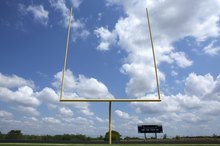Ideal Weight & BMI for Football Players
Kickers notwithstanding, football players tend to be above average in weight and body mass index, or BMI 1. Linemen, in particular, are far above average in both categories. The ideal weight and BMI for an individual player depends on several factors, including his position and his exact responsibilities under a particular team’s style of offense or defense.
They'll Carry that Weight
Linemen engage in a type of hand-to-hand combat on almost every play, and size can be a key factor in who wins most of those battles. As a result, weight and BMI figures that wouldn’t be tolerated at other positions are valued in linemen. The heaviest NFL players are nose tackles, who have an average BMI of about 40.50 1. Defensive ends, who need some speed to rush the quarterback, are much lighter with a typical BMI of 33.83. In college, Division I-A defensive linemen have a typical weight of about 250 pounds and a BMI of 31.2. On average, college offensive linemen have average weights of about 275 and a BMI of 34.4.
- Linemen engage in a type of hand-to-hand combat on almost every play, and size can be a key factor in who wins most of those battles.
- The heaviest NFL players are nose tackles, who have an average BMI of about 40.50 1.
Speed Equals Lightness
Football Goal Post Measurements
Learn More
Wide receivers and defensive backs are typically judged on speed and quickness. NFL wide receivers have a typical BMI of 26.61, while the cornerbacks who oppose them are almost identical at 26.58. Division I-A college receivers and defensive backs both average about 185 pounds. The receivers tend to be taller, so their average BMI is about 23.8, while defensive backs have a typical BMI of 25.1.
- Wide receivers and defensive backs are typically judged on speed and quickness.
- The receivers tend to be taller, so their average BMI is about 23.8, while defensive backs have a typical BMI of 25.1.
Between the Lines
Linebackers must fend off linemen on some plays, and chase down runners or receivers on others. Likewise, tight ends have some blocking responsibilities, but also run pass routes. Neither has to be as large as a lineman or fast as a back. The average college linebacker weighs about 220 pounds and has a BMI of 28.2. At the NFL level, that BMI goes up to about 31.34. College tight ends weigh around 240 pounds with a typical BMI of 29.2. NFL tight ends have an average BMI of about 30.62.
- Linebackers must fend off linemen on some plays, and chase down runners or receivers on others.
- College tight ends weigh around 240 pounds with a typical BMI of 29.2.
Backfield Figures
The Ideal Weight for a Ballerina
Learn More
The size of running backs can vary, depending on their responsibilities. A small runner can rely on speed and quickness, while a fullback whose main job is blocking will be much larger. On average, an NFL running back has a BMI of 30.98, while college running backs weigh 210 pounds with a BMI of 28.5. Likewise, quarterbacks who stay in the pocket and throw -- such as 6 foot 5, 241-pound Ben Roethlisberger -- can be very large 3. Running quarterbacks can be much smaller, like 2014 Super Bowl champ Russell Wilson, who is 5-11 and weighs just 206 4. An average NFL quarterback has a BMI of 27.78, while the number falls to 25 in college, where quarterbacks weigh about 200 pounds.
- The size of running backs can vary, depending on their responsibilities.
- On average, an NFL running back has a BMI of 30.98, while college running backs weigh 210 pounds with a BMI of 28.5.
Related Articles
References
Resources
Writer Bio
M.L. Rose has worked as a print and online journalist for more than 20 years. He has contributed to a variety of national and local publications, specializing in sports writing. Rose holds a B.A. in communications.









